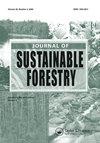孟加拉国东南部森林土地覆盖变化及其社会经济后果
IF 1.8
4区 农林科学
Q3 FORESTRY
引用次数: 1
摘要
摘要几十年来,孟加拉国东南部的山地森林植被一直面临退化和枯竭。该国的森林估计和测绘有充分的记录,主要局限于红树林范围。然而,到目前为止,对孟加拉国山地森林植被的监测是有限的。本研究使用陆地卫星图像监测和分析了1974年至2020年的森林植被覆盖变化,特别是在孟加拉国的Khagrachari和Rangamati山区。我们对卫星图像进行预处理,然后根据图像中的光谱指数执行决策树分类算法。初步评估表明,自1974年以来,研究区域大部分地区的茂密植被/森林植被覆盖率(FVC)呈负变化。进一步的结果显示,19891999年、2010年和2020年,约57.17%、约39.3%、约31.27%和约24.97%的总面积被归类为FVC类型。此外,本研究还简要讨论了FVC的变化如何影响居住在该地区的当地土著社区的生活。这项初步调查强调了研究区域周围约46年的森林砍伐,这可能有利于规划管理和保护森林资源,并保护当地土著社区。本文章由计算机程序翻译,如有差异,请以英文原文为准。
Forest Land Cover Changes and Its Socio-economic Consequences on South-eastern Part of Bangladesh
ABSTRACT Hill forest vegetation cover in the southeastern part of Bangladesh has been facing degradation and depletion over a few decades. The forest estimation and mapping of this country are well documented and mainly restricted to the mangrove extent. However, the monitoring of the hill forest vegetation of Bangladesh is limited till now. This study monitor and analyzes the forest vegetation cover changes using Landsat imagery from 1974 to 2020, specifically in Khagrachari and Rangamati hill district, Bangladesh. We preprocess the satellite imagery and then perform a decision tree classification algorithm based on the spectral indexes derived from the imagery. The initial assessment indicates the negative change of dense vegetation/forest vegetation cover (FVC) in most parts of the study area since 1974. Further results show that ~57.17%, ~39.3%, ~31.27%, and ~24.97% of the total area were classified as FVC type in 1989,1999, 2010 and 2020, respectively. Besides, this study briefly discusses how the change of FVC impacts the life of the local indigenous community living around the area. This preliminary investigation highlights deforestation over the ~46 years around the study area, which could be beneficial for planning to manage and conserve forest resources, and protect the local indigenous community.
求助全文
通过发布文献求助,成功后即可免费获取论文全文。
去求助
来源期刊

Journal of Sustainable Forestry
Social Sciences-Geography, Planning and Development
CiteScore
3.90
自引率
12.50%
发文量
42
期刊介绍:
Journal of Sustainable Forestry publishes peer-reviewed, original research on forest science. While the emphasis is on sustainable use of forest products and services, the journal covers a wide range of topics from the underlying biology and ecology of forests to the social, economic and policy aspects of forestry. Short communications and review papers that provide a clear theoretical, conceptual or methodological contribution to the existing literature are also included in the journal.
Common topics covered in the Journal of Sustainable Forestry include:
• Ecology, management, recreation, restoration and silvicultural systems of all forest types, including urban forests
• All aspects of forest biology, including ecophysiology, entomology, pathology, genetics, tree breeding, and biotechnology
• Wood properties, forest biomass, bioenergy, and carbon sequestration
• Simulation modeling, inventory, quantitative methods, and remote sensing
• Environmental pollution, fire and climate change impacts, and adaptation and mitigation in forests
• Forest engineering, economics, human dimensions, natural resource policy, and planning
Journal of Sustainable Forestry provides an international forum for dialogue between research scientists, forest managers, economists and policy and decision makers who share the common vision of the sustainable use of natural resources.
 求助内容:
求助内容: 应助结果提醒方式:
应助结果提醒方式:


